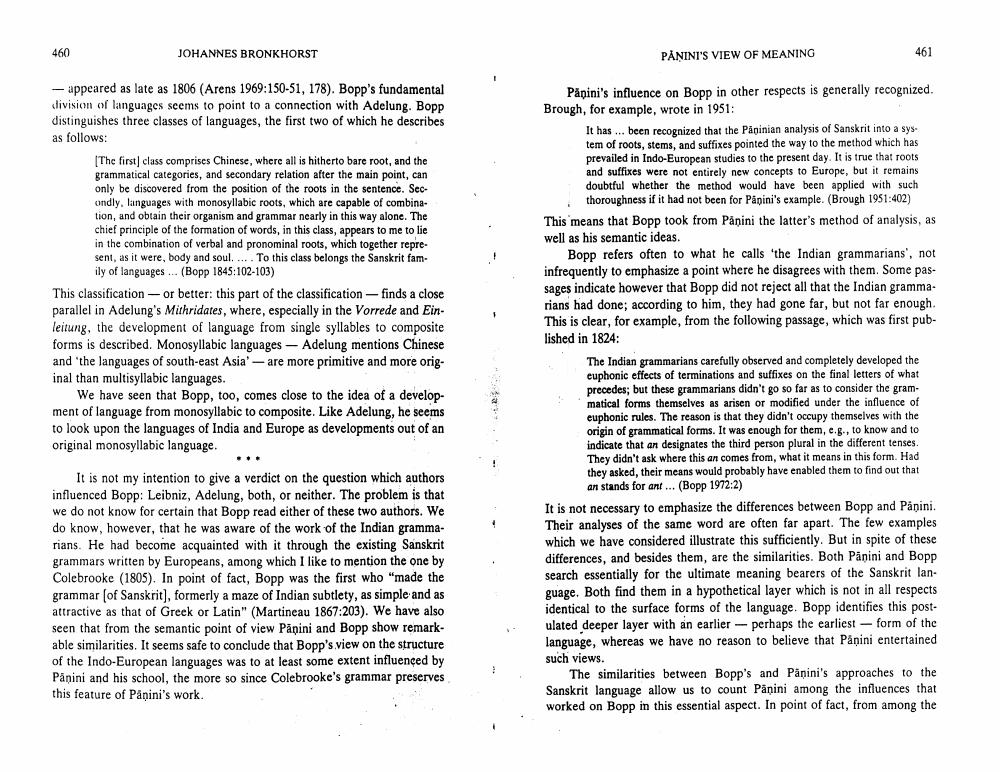Book Title: Paninis View Of Meaning And Its Western Counterpart Author(s): Johannes Bronkhorst Publisher: Johannes Bronkhorst View full book textPage 4
________________ 460 JOHANNES BRONKHORST PÅNINI'S VIEW OF MEANING 461 - appeared as late as 1806 (Arens 1969:150-51, 178). Bopp's fundamental division of languages seems to point to a connection with Adelung. Bopp distinguishes three classes of languages, the first two of which he describes as follows: [The first class comprises Chinese, where all is hitherto bare root, and the grammatical categories, and secondary relation after the main point, can only be discovered from the position of the roots in the sentence. Sec ondly, languages with monosyllabic roots, which are capable of combina tion, and obtain their organism and grammar nearly in this way alone. The chief principle of the formation of words, in this class, appears to me to lie in the combination of verbal and pronominal roots, which together repre. sent, as it were, body and soul. .... To this class belongs the Sanskrit fam ily of languages... (Bopp 1845:102-103) This classification or better: this part of the classification - finds a close parallel in Adelung's Mithridates, where, especially in the Vorrede and Einleitung, the development of language from single syllables to composite forms is described. Monosyllabic languages - Adelung mentions Chinese and 'the languages of south-east Asia'-are more primitive and more orig. inal than multisyllabic languages. We have seen that Bopp, too, comes close to the idea of a develop ment of language from monosyllabic to composite. Like Adelung, he seems to look upon the languages of India and Europe as developments out of an original monosyllabic language. Pånini's influence on Bopp in other respects is generally recognized. Brough, for example, wrote in 1951: It has ... been recognized that the Paninian analysis of Sanskrit into a system of roots, stems, and suffixes pointed the way to the method which has prevailed in Indo-European studies to the present day. It is true that roots and suffixes were not entirely new concepts to Europe, but it remains doubtful whether the method would have been applied with such thoroughness if it had not been for Panini's example. (Brough 1951:402) This means that Bopp took from Pånini the latter's method of analysis, as well as his semantic ideas. Bopp refers often to what he calls 'the Indian grammarians', not infrequently to emphasize a point where he disagrees with them. Some passages indicate however that Bopp did not reject all that the Indian gramma. rians had done; according to him, they had gone far, but not far enough. This is clear, for example, from the following passage, which was first published in 1824: The Indian grammarians carefully observed and completely developed the euphonic effects of terminations and suffixes on the final letters of what precedes; but these grammarians didn't go so far as to consider the grammatical forms themselves as arisen or modified under the influence of euphonic rules. The reason is that they didn't occupy themselves with the origin of grammatical forms. It was enough for them, c... to know and to indicate that an designates the third person plural in the different tenses. They didn't ask where this an comes from, what it means in this form. Had they asked, their means would probably have enabled them to find out that an stands for ant ... (Bopp 1972:2) It is not necessary to emphasize the differences between Bopp and Panini. Their analyses of the same word are often far apart. The few examples which we have considered illustrate this sufficiently. But in spite of these differences, and besides them, are the similarities. Both Pånini and Bopp search essentially for the ultimate meaning bearers of the Sanskrit language. Both find them in a hypothetical layer which is not in all respects identical to the surface forms of the language. Bopp identifies this postulated deeper layer with an earlier - perhaps the earliest - form of the language, whereas we have no reason to believe that Paşini entertained such views. The similarities between Bopp's and Panini's approaches to the Sanskrit language allow us to count Panini among the influences that worked on Bopp in this essential aspect. In point of fact, from among the It is not my intention to give a verdict on the question which authors influenced Bopp: Leibniz, Adelung, both, or neither. The problem is that we do not know for certain that Bopp read either of these two authors. We do know, however, that he was aware of the work of the Indian gramma rians. He had become acquainted with it through the existing Sanskrit grammars written by Europeans, among which I like to mention the one by Colebrooke (1805). In point of fact, Bopp was the first who "made the grammar (of Sanskrit), formerly a maze of Indian subtlety, as simple and as attractive as that of Greek or Latin" (Martineau 1867:203). We have also seen that from the semantic point of view Panini and Bopp show remarkable similarities. It seems safe to conclude that Bopp's view on the structure of the Indo-European languages was to at least some extent influenced by Panini and his school, the more so since Colebrooke's grammar preserves this feature of Panini's work.Page Navigation
1 2 3 4 5 6
